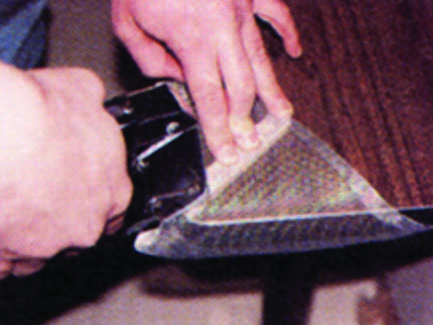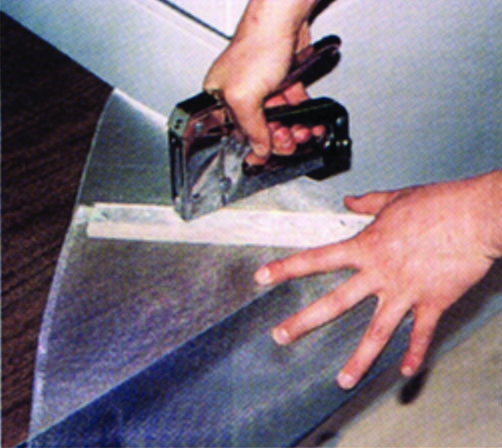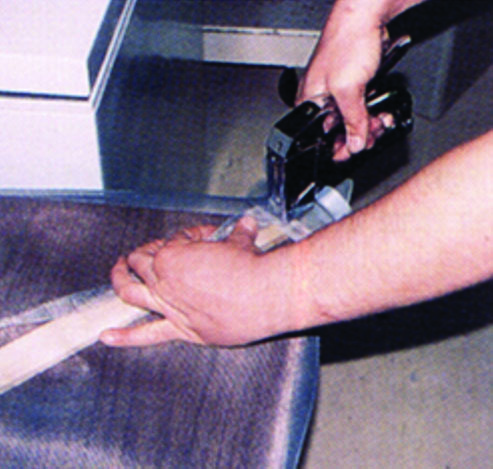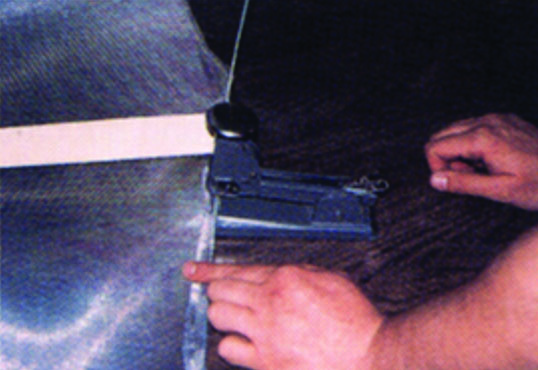Monitoring Adult Weevil Populations in Pecan and Fruit Trees in Oklahoma
The tree trunk is a major structural feature in orchards and landscapes that influences arthropod behavior and habits. Research and Extension personnel have determined that many insects, weevils (Coleoptera: Curculionidae) in particular orient themselves to the tree trunk as a means of finding a mate and a suitable site for laying eggs.
Weevil populations are extremely variable within and among orchards. Each orchard should be monitored accurately to assess weevil population buildup, distribution, and movement into the orchard. Relying on information from a neighbor’s orchard will likely result in poor weevil control.
Several factors can influence the time of weevil emergence and migration into or within an orchard. Nut-bearing trees, such as the pecan, may provide an orientation site for emerging pecan weevils Curculio caryae; however, if fruit is unavailable, their movement within the orchard could be greatly influenced.
The information presented here is intended to describe the use of traps used in monitoring abundance and movement of pecan weevils into and within an orchard or landscape environment. For more information on pecan weevil biology and control consult OSU Fact Sheet EPP-7079 Biology and Control of the Pecan Weevil in Oklahoma and OSU Current Report CR-6209 Commercial Pecan Insect and Disease Control. Additional information on biology and control of plum curculio can be obtained in OSU Fact Sheet EPP-7078 Biology and Control of the Plum Curculio in Fruit Trees in Oklahoma and Current Report CR-6240 Commercial Peach-Nectarine Insect and Disease Control.
Monitoring and Trapping Weevils
Several methods have been used to monitor adult weevil activity. These have included tapping foliage and limbs in the morning to dislodge adults onto a beating tarp or tray, checking fruit periodically for feeding and/or oviposition injury, tree bands, knock down sprays on “scout” trees, and ground cover traps. While these methods are effective, they are also labor intensive and require some careful observation.
The remaining sections of this fact sheet will describe the construction and utility of the most widely accepted traps currently used by growers that provide a route for monitoring weevil populations.
Primary reasons for selecting one trap type over another include number of traps required, cost, labor, and hassles associated with moving or fencing-off traps. The latter problem is a concern where the orchard floor is managed or if livestock are allowed to graze the orchard.
Wire Cone Emergence Trap (Pecans only)
The wire cone emergence trap (Figure 1) is used to monitor emerging pecan weevil populations. Targeted trees for monitoring should have a history of high weevil populations. In addition, if the orchard has different soil types, then weevil emergence in each soil texture should be monitored.
Figure 1. Several wire cone emergence traps within the tree dripline
The cone trap is constructed of 1/8-inch mesh; 21-gauge galvanized hardware cloth, six feet long and 36 inches wide (Figure 2); two 30-inch strips of lath; and a fruit jar and ring. Sides A and B are overlapped and stapled to the same side of the lath. The lath is placed on the inside of the cone before it is stapled. The second lath strip is placed on the outside of the trap and bolted to the underside lath with four uniformly spaced bolts. The fruit jar ring is modified to fasten to the cone trap by using a 24-gauge galvanized soft wire shaped like a “U.” Four pairs of holes are drilled in the jar ring so each hairpin wire can be pushed through the holes and then into the cone trap mesh. The ends of each hairpin wire are tied so that the ring will be secured to the cone trap. A 1/4-inch opening is made at the top of the cone to allow weevils to enter the jar. The jar at the top of the cone trap can be further improved by sealing the jar ring to the cone using hot glue. If the trap is inverted, the hot glue will have a better chance of flowing into the cavities between the ring and hardware cloth. For further modification, a boll weevil trap top can be used instead of the fruit jar and lid. The trap top can be glued into place and the opening enlarged to accommodate pecan weevil entry.
Figure 2. Schematic diagram of the wire cone emergence trap
Upon emerging from the soil, adult weevils are trapped when they crawl up the inside of the cage and through the one-fourth-inch hole at the top of the trap. The trap bottom can be made escape-proof by simply placing soil around the base of the cage. If additional anchoring is needed, three 16-inch pieces of number 9 wire can be bent into a U-shape and inserted through the base of the trap into the soil. Figure 3 shows the suggested arrangement of traps under the tree. There should be 12 traps under each of 10 trees. If the number and arrangement of traps are placed as described, then weevils caught in cone traps can be used to estimate weevil populations in the tree. Monitoring of traps should occur at least every two days. The average number of weevils for the 10 trees, at two-day intervals, should be recorded. When this average reaches 40 weevils, it is time to apply an insecticide. To date, this method is the only absolute sampling procedure that can provide an accurate treatment threshold for pecan weevils. Any attempt to reduce the number of trees monitored and/or number of traps used, automatically compromises the accuracy of this method.
Figure 3. Arrangement of emergence traps under pecan trees to collect adult pecan weevils emerging from the soil.
Pyramid Traps (Both Pecan and Fruit trees)
In 1994, a simplified pyramid trap was developed that simulates the first dark upright object (tree trunk) that weevils see following emergence (Figure 4) within a pecan or peach orchard.
Figure 4. Pyramid trap with boll weevil top.
The pyramid trap can be easily constructed from plywood, particle board, or masonite. The thicker grade material (½-inch or more) will last longer depending on use and exposure to weather. A schematic for construction of four of these traps using one 48-inch x 96-inch x ½-inch sheet of plywood is provided in Figure 5. Markings on the schematic depict where saw cuts should be made. To ensure correct measurements of cuts and minimal waste of materials; measure from left to right along the 96-inch sides as indicated. The two end pieces can be spliced together from the bottom or top side by gluing a 3-inch x 24-inch strip of plywood to each piece to hold them together. A 24-inch split is cut in the bottom (center) of half of the pieces. These splits will provide a means of joining the two halves together to form the final product (Figure 4). Two 1/2-inch holes can be drilled in the bottom of one piece of each trap to accommodate tent stakes, gutter nails, or reinforcement rod to anchor the traps in place. For added security, trap panels can be hinged together using 90° angle iron. Once they are assembled, all traps should be painted using a flat, dark brown, or black, 100 percent acrylic latex paint. Do not dilute the paint – its water-resistant qualities must be retained so traps will not warp. Once the traps have dried, place a modified boll weevil trap assembly on top of the pyramid. The trap top assembly can be secured in place by lightly tapping on the top. Over time, this method of securing the trap top will stretch or break the boll weevil trap assembly; therefore, plastic edging channel can be glued to the inside of the top assembly to accommodate the edge of the paneling. Because the pecan weevil is a much larger insect than the boll weevil, the entrance hole in the wire mesh should be enlarged to 1/4 or 5/16 of an inch in diameter. When this trap is used for plum curculio, the diameter of the weevil entrance hole should not be changed.
Figure 5. Schematic diagram showing the cuts to construct four pyramid traps out of one sheet of 48” x 96” x 1/2” plywood.
Traps should be placed eight to 10 feet from the trunk of pecan trees and adjacent to the trunk on fruit trees. For small pecan trees, place the trap closer to the trunks, generally under the canopy. When trapping under larger pecan trees, place the trap on the north, west, or northwest side of the tree. To further enhance capture using these traps, closely mow or treat with herbicide to control grass and other weeds under the tree and around the trap. Trap operation under pecan trees should begin around July 15. For fruit trees, trap operation should begin when blooms begin appearing (about March 15 in Oklahoma).
To enhance capture within traps and increase repellency on the tree, trunks can be whitewashed with a solution of hydrated lime, salt, and water. Dissolve one pound of salt in two gallons of water. Add the solution to 10 pounds of hydrated lime, and mix well in a five-gallon container. A heavy-duty paint mixer will help with this chore. Screen the mixture through a 20-mesh sieve or standard wire window screen, and stir well before using. This recipe will make 2-1/2 gallons of sprayable whitewash. Large pecan trees may require 1 to 1-1/2 gallons of whitewash to cover the tree trunk. A thicker solution can be prepared for brushing onto the trunk by using only 1-1/2 gallons of water, or white latex paint diluted with 30 to 50 percent water. Painting or whitewashing the tree trunk greatly increases the reflectance of that surface, thereby decreasing its attraction for weevils.
The minimum number of pyramid traps suggested is 15 per 100 acres of trees; however, in smaller orchards or urban environments, as many early maturing indicator trees should be used as possible. One trap per tree is sufficient to help ascertain weevil emergence and general population levels. Operation of this trap type should continue throughout the growing season for plum curculio; however, trapping of pecan weevil can be conducted from late July until shuck split. The traps should be inspected and trap tops cleaned out every two or three days.
Records should be kept to include trap location, number of weevils caught per trap, and date. Convert the total number of weevils collected from all traps on each inspection date into the number of weevils per trap per day. In other words, the total number of weevils caught from “X” number of traps after “X” number of days. For example, if you caught 35 weevils from 15 traps during a two-day period, then divide 35 by 30 (15 traps x 2 days). This tells you that 1.2 weevils per trap per day were captured. The computation should be made on each date the traps are inspected. In pecans, if the number of weevils caught equals or exceeds 0.4 weevils per trap per day, then control measures should be initiated. In peaches, if the number of plum curculio reaches or exceeds 0.045 weevils per trap per day then treatment should be initiated. All records should be kept (for subsequent years) to ascertain any obvious trends over time. This will also help in selecting indicator trees, particularly in pecan. During trap monitoring, be sure to regularly clean the trap screen tops by brushing them with a small, stiff brush to remove spiders, lacewings, webs and other dead insects that could interfere with functioning of the trap. This aspect is particularly important in years with high populations of fall webworms.
Treatment thresholds, for both pests, using the pyramid trap, should serve as general guidelines only. Both weevil species are capable of flight and could theoretically travel from adjacent orchards or native environments. The utility of this trap type has been somewhat limited in Oklahoma pecans, but remains quite important in peaches.
Fruit Tree Screen Trap
Material used for this trap consists of aluminum insect screening 18-inch x 16-inch mesh. Large rolls 36 inches by 100 linear feet are readily available. The initial piece of screening is 10-1/2 inches x 14 inches. Wood lath pieces are 3/4-inch x four inches and 3/4-inch x 6 inches. The screen edge measuring 14 inches is folded to form the cone (Figure 6A). The smaller piece of wood lath is stapled to the folded edge approximately one inch from the bottom and top of the trap (Figure 6B). The small hole created when folding the screen into a cone should have its sharp edges trimmed, but otherwise should be left uncut.
A boll weevil trap top assembly should be trimmed down to the center cone and top ring (Figure 6C). The top ring and screen cone are attached to the folded screen using hot glue (Figure 6D). At this time, the hole created from folding the screen material into a cone can be tacked to the top assembly to prevent weevils from becoming trapped between the two layers of screening (Figure 6E). The next step simply involves attaching the larger piece of wood lath to the side of the trap opposite the first piece (Figure 6F). Finally, a 1 5/8-inch drywall screw is anchored into the second piece of wood lath (Figure 6G). Do not place the screw through the wood lath. It serves as a separator to prevent the trap from closing when attached to smaller trees. Do not use screws to attach the trap to fruit trees since this could injure the tree and cause pitch to flow from the wound. Use rubber strapping or baling twine to secure the trap to the tree (Figure 7).
The screen trap for fruit trees was developed in Oklahoma in 1997 and has undergone evaluation in several peach orchards in Oklahoma, Arkansas, and Alabama. Results indicate it is comparable to the pyramid trap in capturing plum curculio in certain orchards, but not as efficient in peaches as the pyramid trap. It has shown great promise in the Midwest for producers growing other fruit trees where this insect is a problem. In Oklahoma, the present recommendation is the pyramid trap for monitoring plum curculio in peaches; however, this smaller trap type has shown excellent utility in young pecan orchards, where the Circle trap is too big. As researchers, Extension personnel, and growers become more familiar with this trap design, modifications will be made to increase its utility.
Figure 6. Step-by-step (6A-G) construction of the fruit tree screen trap, used in monitoring for plum curculio.
Figure 6A. Fold 14-inch edge into a cone.
Figure 6B. Staple smaller wood lath to inside of cone.
Figure 6C. Trim down boll weevil trap top.
Figure 6D. Attach ring using hot glue
Figure 6E. Seal two layers of screening together
Figure 6F. Staple larger wood lath to inside of cone.
Figure 6G. Anchor dry wall screw into larger piece of wood lath. Do not go through the wood.
Figure 7. Attach the screen trap to fruit trees using rubber strapping or baling twine.
Pecan Tree Circle Trap
Because wire cone emergence traps and pyramid traps on the orchard floor are obstacles to mowing and grazing and because they can be easily damaged by livestock and mowing equipment, alternative designs were explored by Extension personnel in Oklahoma and Kansas. Extensive evaluations on a trap design developed by a Kansas pecan grower, Edmund Circle, have resulted in identifying a viable alternative to trapping for weevils on the orchard floor. The Circle trap (Figure 8) consists of a wire screen cage with a boll weevil trap top (modified slightly) which is attached directly to the tree. Therefore, the visual cue of the tree is exploited and nothing clutters the orchard floor. Since tree size varies greatly, trap size and design must be modified. Measurements and design of standardized traps developed for medium to large pecan trees follows.
Material used for this trap consists of aluminum insect screening mesh (32 inches x 24 inches). Two wood lath pieces, 1 1/2 inches wide x 17 3/4 inches long, and 1 1/2 inches wide x 11 1/2 inches long are needed. The longer (32-inch) edge of the screening is folded into a cone shape, slightly overlapped, and stapled to the shorter piece of wood lath (Figure 9A), approximately one inch from the bottom of the seam and top of the wood lath.
Excess screening is cut away at the cone top to accommodate the trap top assembly (Figure 9B and C). The top assembly is placed between the screen and the wood lath and stapled into place (Figure 9D). The longer piece of wood lath is also stapled to the screening and top assembly directly opposite the first piece of wood (Figure 9E). A 32-inch piece of nine- to 10-gauge steel wire is stapled into a fold created on the shorter side (outside) of the trap using number 13 book binding staples (Figure 9F). The wire serves to hold the outside part of the trap open, away from the tree, so that weevils may enter easily.
Figure 8. The circle trap devised by Edmund Circle, Kansas pecan grower.
Figure 9. Step-by-step (9A-G) construction of the pecan tree circle trap, used in monitoring for pecan weevils.
Figure 9A. Staple the longer edge of screening to the shorter piece of wood lath to form a cone.
Figure 9B. Cut away excess screening to accommodate trap top assembly.
Figure 9C. Position trap top in place between screening and wood lath.
Figure 9D. Anchor trap top between screening and wood lath and staple in place.
Figure 9E. Staple longer piece of wood lath to screening and fold wire into place (smaller wooded side).
Figure 9F. Staple 9- to 10-gauge wire into fold on shorter side using no. 13 book-binding staples.
Figure 9G. Seal trap top assembly into place using hot glue.
Finally, the trap top assembly is sealed to the screening and wood lath using hot glue (Figure 9G). Remember, for pecan weevils the entrance hole at the top of the cone should be enlarged to 1/4- to 5/16-inch. The trap is attached to the tree using two, 1 5/8-inch drywall screws and the bottom of the screening is stapled or strapped to the tree (Figure 8). If the bottom is stapled to the tree, trap removal will likely damage the screening unless staples are carefully removed. Research conducted in 1996 suggests that placing traps on the north, west, or northwest side of trees is preferred. In addition, placing traps as high on the trunk as possible is also suggested to protect them from damage by curious cattle that may be grazing in an orchard. If no livestock grazing is occurring in the orchard, simply place traps at a convenient height for trap top inspection.
Use of rubber strapping material, baling twine, or similar material will also work well to secure the trap to the tree; however, these materials should be checked regularly for signs of weathering. In addition, to ensure weevils move into the trap and not beneath the screening, a draw knife can be used to smooth out the roughness of the bark. Be certain not to shave off excessive amounts of bark, since this could injure the tree or increase its susceptibility to winter injury. Experiments conducted in Oklahoma have revealed these traps capture greater numbers of pecan weevils than pyramid traps. Information obtained from monitoring pecan weevils using this trap type can be used as an indicator of weevil presence and relative abundance.
Research conducted during a three year period in Oklahoma, using comparative analyses of the various trapping tools for pecan weevil have determined that if the number of weevils captured equals or exceeds 0.3 weevils per trap per day (when the tree is encircled with traps) then treatment should be initiated. This threshold; however, represents a rough estimate based on comparisons between trap types. Using 0.3 weevils per trap per day in conjunction with a cumulative capture total, taking into account the value of the crop, potential quality and estimated cost of treatment can help further refine the treatment threshold. Based on a predictive equation that estimates the number of weevils in a tree or orchard over time researchers in Oklahoma determined that 40 weevils captured under 10 trees equals about 600 weevils per acre. Using this piece of information, in conjunction with a static economic threshold developed in Texas, we have developed a dynamic economic threshold that allows us to anticipate treatment based on concurrent captures of weevils in traps. The following equation can be modified to fit any particular orchard situation:
W = N x M/ P x D
Where:
N = number of nuts/Kg (e.g. 198.4 nuts/Kg = 90 nuts/lb)
M = estimated cost of three treatments (e.g. $177.84/ha = $60/A x risk factor of 0.2 = $72/A)
P = value of pecans (e.g. $.86/Kg = $0.39/lb)
D = 15 damaged nuts/weevil
In this equation, the risk factor of 0.2 represents the potential risks of doing business, some of which are imposed by the weevil population (prolonged, heavy emergence) or applicator (rain just after an application) and some that cannot be controlled by the applicator or grower (freezes, hurricanes, tornadoes, etc.) D is a constant based on the average number of nuts a post emergent pecan weevil will damage.
Following the examples provided above for a small seeded, low return ($) native then:
198.4 x 177.84 ÷ 0.86 x 15 = 2,735 weevils / ha (1,107.7 weevils/acre)
This number (1107.7 weevils/acre) represents the static economic threshold (SET). Using the previous estimate of 40 weevils captured under 10 trees with wire cone emergence traps represents 600 weevils per acre, and assuming that an equal comparison of captures in these traps with those of Circle traps can be done, we can calculate a dynamic economic threshold (DET) based on concurrent captures in Circle traps. As an example:
If by August 21, 67 total weevils have been captured in 20 traps on 10 trees, this would extrapolate to 1,005 weevils per acre by:
40 weevils ÷ 600 weevils/A = 67 weevils ÷ ‘X’ = 1,005 weevils per acre
If we check traps two days later and 90 total weevils (23 more) have been captured then this would translate into 1,350 weevils /acre; well in excess of the SET calculated above. In essence, when the cumulative number of weevils captured in 20 Circle traps on 10 trees exceeds 73, our DET is attained. Calculating and using this number in conjunction with determining when 0.3 weevils per trap per day have been reached can help to pinpoint the economic threshold for each grower based on treatment costs and potential value of the crop. Growers should be encouraged to calculate their own SET and DET utilizing their specific inputs relative to quality and potential prices.
Currently, in comparing costs of the three trap designs mentioned in this fact sheet, the Circle trap is the least expensive, followed by the pyramid and wire cone emergence traps. Obviously, the Circle trap is the most compatible design for use with grazing livestock or orchard floor maintenance and captures more than three times as many pecan weevils than either of the other trap types.
Phillip G. Mulder
Extension Entomologist
Oklahoma State University





















